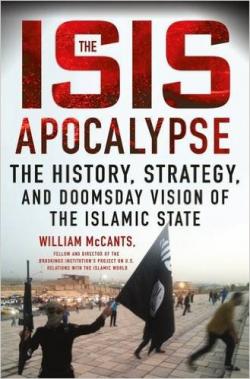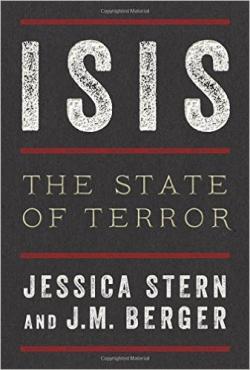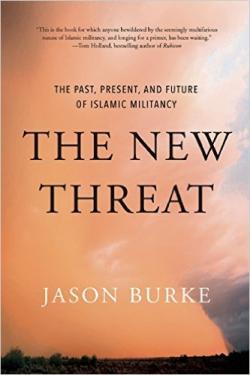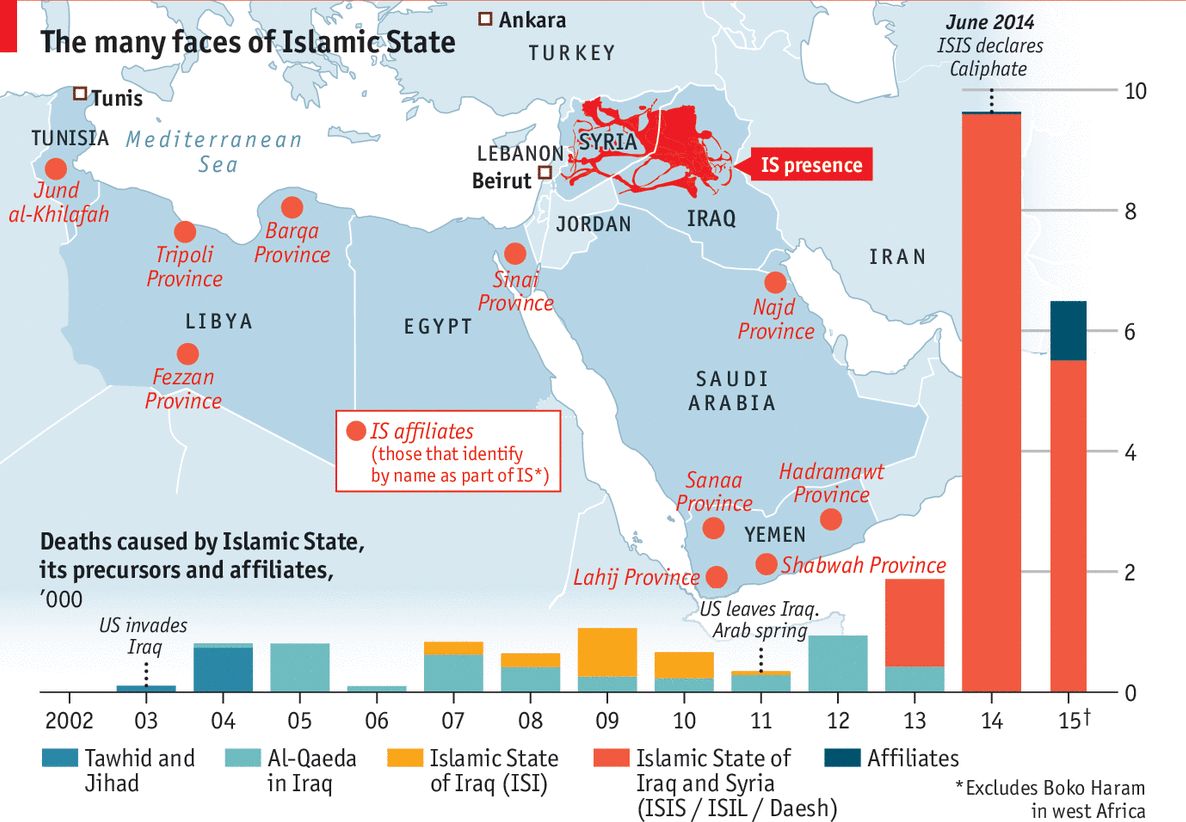


Half a dozen recent books have recounted how the Islamic
State (ISIS) emerged in Iraq in 2006, established itself in Syria in 2011 and
swept back into Iraq last year. However three books in
particular merit attention; ISIS: The State of Terror by Jessica Stern and J.M.
Berger; The ISIS Apocalypse: The History, Strategy, and Doomsday Vision of the
Islamic State by William McCants; The New Threat: The Past, Present, and Future
of Islamic Militancy by Jason Burke. Taken together, they represent the most
authoritative portrait available of a movement that continues to mutate.

Jason Burke, veteran Observer and Guardian correspondent and author of
the bestselling Al-Qaeda, identifies the population explosion in countries such
as Egypt and Tunisia as a major factor in the rise of Islamic militancy.
Jessica Stern and J M Berger believe that Isis “emerged from the mind” of a
street thug from the Jordanian city of Zarqa, who called himself Abu Musab
al-Zarqawi.
The key to Isis is to grasp how the movement arose from this split
within al-Qaeda. Bin Laden and his followers strained every sinew to strike the
“far enemy”, namely America and the West; Zarqawi, by contrast, was obsessed
with killing the “near enemy” represented by the Shia. Bin Laden used wanton
violence in a way that he hoped the wider Muslim “Umma”, or nation, would be
willing to support. Zarqawi saw bloodshed as an end in itself and believed that
a promise of limitless killing would win sufficient recruits. Bin Laden ran
al-Qaeda as a secret society comprised of autonomous cells; Zarqawi was willing
to accept almost any Sunni into his command, provided they had no qualms about
atrocities.
McCants is an Islamic specialist at Brookings Institution, a Washington
think-tank, and co-editor of a respected website (jihadica.com). His
contribution is to provide something close to an inside account by drawing on
leaked or captured e-mails and other messages. His explanation is essentially
threefold.
First, a more credible leadership emerged. The new emir, Abu Bakr
al-Baghdadi, claimed descent from the Prophet, had a degree in Koranic studies,
and was shrewd and well-connected. Helping him consolidate power was the
sinister Hajji Bakr, a bald, white-bearded former colonel in Saddam Hussein’s
army, whose first act was a Saddam-like purge of potential rivals.
Second, events in Syria between 2011 and 2014 played into IS’s hands,
giving it a powerful new base and precipitating the final break with al-Qaeda.
Their divorce, Mr
McCants calls it the “biggest split ever in the global jihadist community,”
left IS pre-eminent and al-Qaeda gravely weakened.
Third, IS’s proclamation in 2014 of the restoration of the caliphate, in
Islamic prophecy, one of the portents of the apocalypse, proved to be a
masterstroke. Bin Laden had paid lip-service to the idea but had never taken it
very seriously. When IS threw caution to the wind, many Muslims around the
world rushed to fight under its black banner. The movement soon had an
estimated 20,000 foreign fighters.
Basically all three books show how the Islamic State represents a new
and more dangerous evolution in the development of violent extremism and
demonstrate its deep roots in Islamic history. They stress its control of
social media and its apocalyptic vision, which are unique among current
terrorist groups.
It will threaten the West with the possibility of mass-casualty
terrorism. But its ultimate goals are impossible for the organization to
achieve, and a broad coalition of countries is now opposed to its expansion.
In 2004, Osama bin Laden reluctantly gave his blessing for the Jordanian
jihadist Abu Musab al-Zarqawi to establish a local branch of al Qaeda in Iraq.
In the words of Stern and Berger, Zarqawi was a “thug-turned-terrorist who
brought a particularly brutal and sectarian approach to his understanding of
Jihad.” It was Zarqawi who popularized the genre of filmed beheadings. Zarqawi,
unlike bin Laden, believed that all Shiite Muslims should be killed and had no
compunction about murdering Muslim civilians, to bin Laden’s consternation.
Zarqawi’s bloody rampages and his fixation on instigating a sectarian war
between Sunnis and Shiites horrified bin Laden and his deputy, Ayman
al-Zawahiri, who repeatedly but unsuccessfully urged Zarqawi to change course.
After Zarqawi’s death in a 2006 U.S. air strike, his organization rebranded
itself as the Islamic State of Iraq (ISI).
The U.S. troop surge in Iraq in 2007 and Iraq’s so-called Sunni
Awakening, when the country’s Sunni Arab communities turned against al Qaeda
and other extremist militants, succeeded in greatly weakening ISI. Yet with the
increasingly violent sectarianism of Iraqi Prime Minister Nouri al-Maliki, a
Shiite, and the withdrawal of U.S. troops, Sunni communities found themselves
disenfranchised, and ISI successfully exploited these fears to recover its
strength. The outbreak of civil war in Syria in 2011 allowed the group to
expand across the border, and it changed its name again, this time, in 2013, to
the Islamic State of Iraq and al-Sham. Then, in June 2014, the group returned
to northwestern Iraq, seized Mosul, and declared the caliphate.
Although undeniably dramatic, the group’s declaration of a new caliphate
under Baghdadi was not an unprecedented move, nor is its exploitation of
apocalyptic prophecies. Throughout Islamic history, many figures have claimed
the title of caliph, or ruler of all Muslims, with varying degrees of success.
Some of them have waged violent campaigns to establish their legitimacy.
Islamic history is also replete with false prophets, some of whom have declared
themselves to be the Mahdi, the savior that some schools of Muslim theology
predict will appear before the apocalypse.
The group’s constant invocations of the Day of Judgment and the end of
time have deep roots in Muslim history. McCants describes the “striking
parallels” between the rhetoric and iconography of the Islamic State and those
of the
Abbasid Revolution of
750, when rebels flying black flags overthrew the second caliphate and
established a third. During that period of upheaval, he writes, “apocalypse,
caliphate, and revolution were inseparable, just as they are for the Islamic
State.”
The Islamic State
also has more recent antecedents. As McCants writes, the group’s “theology and
method of engaging with scripture is similar to salafiyya and Wahhabism. McCants notes that when the Islamic State needed to
distribute educational materials to schoolchildren in its stronghold in Raqqa,
Syria, “it printed out copies of Saudi state textbooks found online.
Unsurprisingly then, most of the Islamic State’s hudud penalties [the fixed
punishments specified in Islamic Scripture for the most egregious crimes] are
identical to penalties for the same crimes in Saudi Arabia.”
The similarities between the Islamic State’s theology and Wahhabism are
perhaps unsurprising, given the Islamic State’s roots in Wahhabi-influenced al
Qaeda. In his compelling and meticulously researched book The New Threat, Jason
Burke analyzes the origins of global jihad and the unique role of al Qaeda in
shaping its development. Burke, a veteran foreign correspondent for The
Guardian, traces the intellectual progenitors of the modern ideas of jihad that
inspired bin Laden and his followers. The key figures include Sayyid Qutb, the
theoretician of the Muslim Brotherhood and an iconic figure in Islamist
militancy, and Abdullah Azzam, a charismatic Palestinian ideologue and
polemicist whose call for Muslims to engage in “defensive jihad” was
instrumental in mobilizing support and fighters for the war against the Soviets
in Afghanistan. Qutb was hanged by Egyptian authorities in 1966, and Azzam was
killed by a car bomb in 1989, but their ideas outlived them.
Bin Laden used the teachings of Wahhabism and the legacies of Qutb and
Azzam to construct “a global narrative: of the cosmic struggle between good and
evil, belief and unbelief, the mujahideen and the Crusader-Zionist Alliance,”
Burke writes. This Manichaean view of the world, divided sharply between the
forces of good and the forces of evil, between Muslims and infidels, would be
even more strongly emphasized by the Islamic State in the years following its
split with al Qaeda. As McCants argues, “The U.S. invasion of Iraq and the
stupendous violence that followed dramatically increased the Sunni public’s
appetite for apocalyptic explanations of a world turned upside down.” The
masked armies of the Islamic State—its soldiers brandishing swords, storming cities,
and daring the West to fight a final cataclysmic battle—have hardly appeared
from nowhere. They are just another extremist group, made up of violent men
driven by the same absolutist and apocalyptic impulses that have motivated
similar organizations in the past.
And yet despite the similarities between the Islamic State and previous
theocratic revolutionaries, from the Abbasids to the Wahhabis, the rise of the
Islamic State represents something new and modern. The technologies of
globalization offer contemporary radical extremists opportunities to reach mass
audiences their predecessors could never have imagined, and the Islamic State
has exploited these technologies more successfully than any of its
contemporaries in the Islamist world. Stern and Berger’s book provides the most
compelling analysis yet of the group’s creative and sophisticated propaganda
efforts and its unprecedented use of social media. The Islamic State has
several thousand active online supporters who operate in disciplined regiments.
After the group posts something to the Internet—say, a beheading video—and it
is authenticated, a second-tier regiment takes to Twitter to “retweet the link
with a hashtag, then retweet each other’s tweets and write new tweets.” At
coordinated times, online hashtag campaigns generate hundreds of similar tweets
to create a “Twitter storm.” Other members upload the material to multiple
platforms so that it remains available even if Internet providers pull the
content down. If “al Qaeda was publicity-shy . . . ISIS, in contrast, is a
publicity whore.”
This mass online campaign has attracted supporters from all over the
world; some estimates place the number of foreign fighters in Iraq and Syria at
around 20,000. Their reasons for joining the jihad vary, from the promise of
living in and defending the world’s only ostensibly true Islamic state, to the
opportunity for camaraderie and a sense of purpose, to the simple thrill of
murder and the officially sanctioned practice of sex slavery, which The New
York Times dubbed “a theology of rape.” Not much is known about the volunteers
who have since returned to their native countries, perhaps disillusioned and
repentant, or possibly plotting terrorist attacks. The phenomenon of fighters
volunteering abroad is not in itself a new one, in the Spanish Civil War, thousands
of Americans and Europeans volunteered to fight for the Republicans against the
Nationalists. And jihadist organizations have always attracted foreign
militants. Yet the scale of the Islamic State’s online presence and the ease
with which a European extremist can travel to Syria have contributed to far
greater numbers of Western volunteers serving with the group than ever fought
for al Qaeda.
The Islamic State has distinguished itself from all past extremist
organizations in the sophistication and scale of its use of social media.
The Islamic State is also different from recent jihadist movements in
the size of the territory it controls. Unlike al Qaeda, which was never
particularly interested in governing or in seizing and controlling land, and
which preferred to launch attacks on the U.S. homeland, the Islamic State has
always wanted a state in the Middle East. As Burke writes, “Zarqawi’s strategy
was simple: to seize and hold real ground, to endure and expand, as the Islamic
State’s motto later put it.” And this territory now generates a level of wealth
for the Islamic State that al Qaeda never possessed. Many experts believe that
the group is more than capable of financing itself through taxes and extortion,
through which it takes in more than $1 million per day, as well as oil revenues.
The Islamic State may well be the richest terrorist group ever.
The Islamic State is not as terrifyingly new as so much of the media
coverage has claimed, but as these books illustrate, it represents a more
dangerous evolution in the jihadist movement, one that must be understood
accurately if it is to be defeated. In the current debate among historians,
journalists, policymakers, and scholars about the nature of the group, there
are those who seek to deny that it is rooted in Islamic traditions and who
claim that the self-declared caliphate has hijacked a religion of peace and
distorted its humane message. Such views ignore the fact that none of the three
major monotheistic religions can be considered wholly peaceful: in their sacred
texts, Christianity, Islam, and Judaism all contain elements of brutality and
violence. But religions cannot and should not be understood by their texts
alone. The lived history of a community of believers defines a religion; a
great deal depends on how the custodians of a faith choose to interpret,
defend, exploit, or abuse its sacred texts. The crusaders who slaughtered their
way to Jerusalem in 1099 were as Christian as the Christians of the Renaissance
and of today. The Islamic State is as much a part of Islam as Baghdad, Cairo,
Córdoba, and Damascus were during their golden ages as centers of learning and
high culture.
It is crucial, for the Islamic world above all, to recognize that the
Islamic State has deep roots in Islamic traditions. Containing it will require
the support of Arab and Muslim allies, and it is only by placing the group in
the proper historical and cultural context that it can be demystified in the
Muslim world. Once Muslims in the Middle East free themselves from the delusion
that the Islamic State is a wholly alien phenomenon and recognize that the
group’s false Mahdis and caliphs are but the latest in a long and bloody
genealogy, they might come to see the fight against the Islamic State for what
it is: a struggle to determine which tradition within Islam will define the
religion going forward.
The authors of these three books do not foresee the group’s demise in
the near future. They counsel Western powers against overreacting to the
threat, which would undermine civil liberties at home and deepen the rift
between Western countries and Muslim-majority states. But the Islamic State
will not simply collapse on its own. The fight against the group is as much a
war against an idea as it is a battle against armed militants. It must be
fought not only on the front lines of Iraq and Syria but also on every
platform, electronic or otherwise, that the extremists use to spread their
vision.
For updates
click homepage here